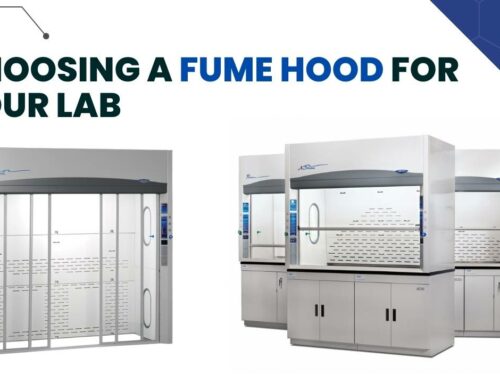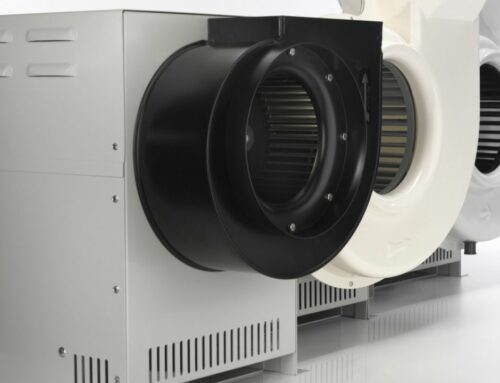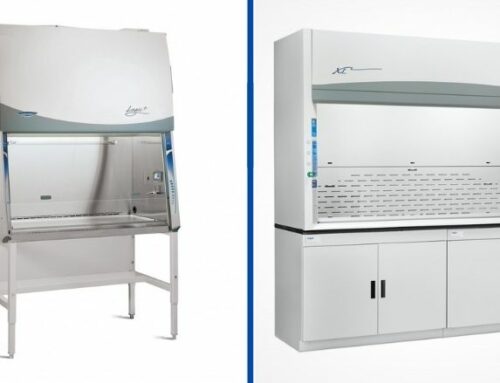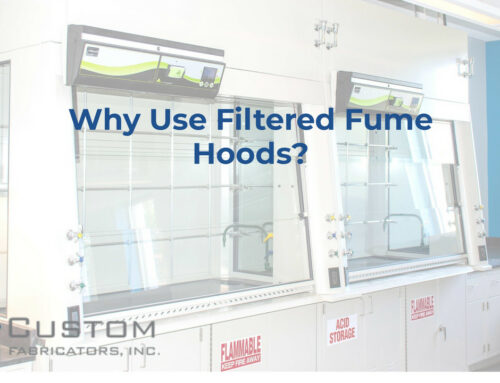Laboratory Fume Hood Installation & Blower Selection
A laboratory fume hood is a ventilated enclosure that captures, contains, and exhausts toxic or harmful fumes or vapors. It minimizes inhalation and contact, thus providing a safe working environment.
One overlooked – yet crucial – step when selecting and installing a fume hood is the blower and associated ductwork.
In ducted hoods, a blower pulls air from the laboratory into and through the hood. It then pushes contaminated air through the exhaust system to the atmosphere via ductwork. Thus, all components work simultaneously to ensure the optimal performance of the hood.
Fume hood blowers are available in different styles, sizes, and materials and can handle varying chemical resistance, airflow, and static pressure.
Selecting a suitable blower is critical to maintaining the safety and containment of your fume hood. It will also ensure the superior performance and long life of your blower when subjected to chemical atmospheres.
What does the typical fume removal system look like?
A typical fume removal system captures and exhausts contaminants or toxic fumes from working with hazardous chemicals or biohazards.
There are two types of fume removal systems: ducted and ductless.
Ducted fume hoods connect to the building HVAC system and use it as the exhaust vent. They have an exhaust blower that pulls laboratory air into and through the hood, and ducting carries air outside the building offering maximum protection.
Ductless fume hoods exhaust contaminants by moving air through HEPA or ULPA filters and recirculating it through the lab. While ductless fume hoods are economical and easy to install, they have a more limited range of chemical removal. Thus, ducted ventilation systems are popular in labs that undertake a wide variety of applications.
The figure below depicts a typical fume removal system. When purchasing a fume hood, all of the ductwork and blower components must be considered and potentially installed onsite.

Laboratory fume hood installation process
Installation of a new fume hood (chemical fume hoods or biosafety cabinets) or replacing old ones requires careful planning and knowledge of the existing building ventilation systems and capabilities.
Fume hood installation requirements include:
- Location requirements: The lab layout and fume hood location are critical for optimal performance and minimal interference. Install hoods away from constant traffic patterns, doors, windows, fans, or any air-handling devices that could disrupt its airflow patterns.
- Support or work surface requirements: Some chemical hood designs require that you place them on top of workbenches. In contrast, others come with work surfaces designed with this compatibility. If you have an existing workstation, ensure it is of the appropriate size, material, and strength for your needs. A floor mounted fume hood may have completely different requirements.
- Ductwork requirements: Installing a ducted fume hood requires fitting ductwork and deciding on a mechanical system. The systems can either have constant air volume (CAV) or variable air volume (VAV). CAV systems exhaust a steady volumetric flow of air. In contrast, VAV systems may incorporate valves or dampers to lower air volumetric flow, resulting in energy savings.
- Electrical power requirements: Every hood comes with its own set of requirements. These must be strictly adhered to, so as not to compromise electrical safety and impair protection.
- Blower requirements: The purpose of fume hood blowers is to control airflow into and through the hood. There are two fume hood blower configurations: a built-in and remote.
- A built-in blower mounted on the laboratory hood is economical and easy to install. It is ideal for short, straight duct runs and low toxicity applications. However, it is noisier than the remote installations. Remote blowers are typically located on the rooftop and pull air through the ductwork to be exhausted outside.
Remote blowers are most popular compared to built-in blowers because:
- Built-in blowers don’t meet ANSI Z9.5: Clearly states that lab exhaust fans shall be located physically outside the lab building. Preferably on the highest-level roof of the building served.
- Remote blowers are failsafe. For example, if there is a leak in the ductwork, the ductwork is kept under negative pressure. Clean air will be pulled through the leak and exhausted instead of pushing contaminated air out of the leak. Built-in blowers are not a one-size-fits-all, and they are loud.
How to choose the right fume hood blower
The type of application often dictates what type of blower to use. For example, the epoxy-coated steel blower is only ideal for venting non-toxic materials. If you deal with volatile chemicals, acid-resistant blowers made from PVC, polypropylene, or fiberglass-reinforced plastic would be best.

Factors to consider when choosing a blower are:
-
- Construction material: What chemical fumes will be present in your lab? Blowers come in different materials that withstand various conditions. The common types of materials include:
- PVC: These blowers are suitable for perchloric acid and other highly corrosive applications.
- Steel: These work best for low to moderately corrosive applications. For example, the Labconco coated steel blowers offer a broad spectrum of capacities from 300 to 2150 CFM at static pressures to 1.50″.
- Fiberglass: These are best for moderate to highly corrosive conditions because it is more solvent and acid-resistant. Fiberglass and plastic blowers are also ideal if you work with volatile or explosive material because they are explosion-proof. They are offered in a range of capacities from 250 to 3500 CFM at static pressures to 4.0″. Fiberglass is the standard material of choice if future applications are unknown. Choose a blower material that matches the liner of your fume hood and is compatible if you are in doubt about which would be suitable.
- Construction material: What chemical fumes will be present in your lab? Blowers come in different materials that withstand various conditions. The common types of materials include:
Fiberglass is the standard material of choice if future applications are unknown. Choose a blower material that matches the liner of your fume hood and is compatible if you are in doubt about which would be suitable.
Sizing Your Fume Hood Blower
The fume hood blower sizing is critical to the performance of the hood. A weak blower will not effectively remove contaminated air. At the same time, an extra-strong one could overpower the ductwork and create turbulence around equipment or containers.
Fume hoods and ductwork systems create static pressure (resistance to airflow) measured in inches of water gauge (WG). A variety of factors that impede the free flow of air cause this resistance. They include the presence of air supply diffusers, duct diameter, length of the ductwork, number of elbows in the ductwork, and the degree of the elbow bend.
To determine the right size for your blower, provide answers to the following:
- What is the duct diameter in inches?
- What is the total length in feet of the straight duct run?
- What is the number of 900 and 450 bends and elbows?
Typically, at least one 90-degree bend is at the roof penetration, and 3-5 duct diameter lengths (approximately 3-5 feet) between elbow and blower are required.
CFI offers Thermoplastic Ducting in 10 ft. lengths if you have a facilities team capable of installing or we could partner with a General Contractor/HVAC relationship to provide you with a turnkey solution.
- What type of weather cap will be required?
- What’s the operating temperature and altitude from sea level?
- Is the roof warrantied?
- What are the implications of cutting a hole and hiring a competent installation crew?
The answers will help you determine the required face velocity, hood sash height, volumetric rate, and static pressure. Manufacturers provide this information for each fume hood, thus, you can then match your requirements to help you find the right-sized blower.
- Operating speeds: Two different types cover a wide range of applications:
- Belt-driven: This single-speed piece of equipment works best for labs that operate CAV fume hoods.
- Intelli-sense multi-speed blower offers up to three speeds. It is suitable for small labs looking for energy efficiency to alleviate the burden of high energy costs.
- Accessories: You may add accessories to your system to help your fume hood and blower to operate at optimum levels. These may include a manual duct damper to control airflow, a zero pressure weather cap to exhaust air vertically without stoppage, and an airflow monitor. Some applications may require wash-down systems to neutralize acid remnants.
How can CFI help?
Properly installing a laboratory fume hood and blower selection can be challenging. You may need the help of experts to establish the relationship between the face velocity and static pressure and to put together all the pieces of information needed to choose the suitable blower.
CFI experts will work with you to properly select and install your lab fume hood, blower, and ductwork for optimal performance.






